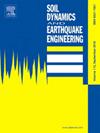A new collapse mechanism of RC frame structures under earthquakes: Shaking table tests and numerical analysis
IF 4.2
2区 工程技术
Q1 ENGINEERING, GEOLOGICAL
引用次数: 0
Abstract
For the reinforced concrete (RC) frame structures under mega earthquakes, it is well acknowledged that damage primarily concentrates at beam ends and column ends. Successively, a certain number of plastic hinges develop which can trigger the structural collapse. However, the present study found that the plastic hinges could form at the mid-span of the first story beams in an RC frame structure configured with a slab opening on one side of the first floor. To investigate the failure behavior and collapse mechanism, first, shaking table tests were conducted on three 1/10-scale three-story RC frame models M1, M2 and M3, each configured with a slab opening on one side of the first floor. The models M1 and M2 were identical and conducted for repetition, while the model M3 served as a reference and was strengthened at the mid-span of the first story beams to prevent from forming a plastic hinge at this location. Then, the time history analysis and pushover analysis were performed using the finite element method. Finally, the prototype RC frame structures were numerically simulated till collapse under five bidirectional earthquakes. Test and numerical results found that for the models M1 and M2, the plastic hinges consistently formed at the mid-span of the first story beams and contributed to the new collapse mode towards the side with the slab opening. However, for the model M3, the plastic hinges concentrated at the beam ends and columns ends, behaving in the commonly recognized collapse towards the side without the slab opening. The pushover analysis found that the slab on one side of the first floor significantly influenced the distribution of cross-sectional bending moments along the first story beams, leading to the plastic hinges developing at the mid-span of the first story beams.
求助全文
约1分钟内获得全文
求助全文
来源期刊

Soil Dynamics and Earthquake Engineering
工程技术-地球科学综合
CiteScore
7.50
自引率
15.00%
发文量
446
审稿时长
8 months
期刊介绍:
The journal aims to encourage and enhance the role of mechanics and other disciplines as they relate to earthquake engineering by providing opportunities for the publication of the work of applied mathematicians, engineers and other applied scientists involved in solving problems closely related to the field of earthquake engineering and geotechnical earthquake engineering.
Emphasis is placed on new concepts and techniques, but case histories will also be published if they enhance the presentation and understanding of new technical concepts.
 求助内容:
求助内容: 应助结果提醒方式:
应助结果提醒方式:


